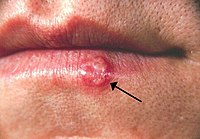
Photo from wikipedia
These updated guidelines from the Infectious Diseases Community of Practice of the American Society of Transplantation review the diagnosis, prevention, and management of HSV in the pre‐ and post‐transplant period.… Click to show full abstract
These updated guidelines from the Infectious Diseases Community of Practice of the American Society of Transplantation review the diagnosis, prevention, and management of HSV in the pre‐ and post‐transplant period. A majority of transplant recipients are seropositive for HSV‐1 or 2. Compared with immunocompetent persons, SOT recipients shed HSV more frequently, have more severe clinical manifestations, and are slower to respond to therapy. Most HSV infection is diagnosed on clinical grounds, but patients may present with atypical lesions and/or other clinical manifestations. Acquisition from the donor is rare. Polymerase chain reaction is the preferred diagnostic test unless culture is needed for resistance testing. For limited mucocutaneous lesions, oral therapy can be used; however, in severe, disseminated, visceral or CNS involvement, acyclovir doses of up to 10 mg/kg every 8 hours intravenously should be initiated. Acyclovir‐resistant HSV is less common in SOT patients than in HSCT and can be treated with foscarnet, though other novel therapies are currently under investigation. HSV‐specific prophylaxis should be considered for all HSV‐1 and HSV‐2–seropositive organ recipients who are not receiving antiviral medication for CMV prevention that has activity against HSV.
Journal Title: Clinical Transplantation
Year Published: 2019
Link to full text (if available)
Share on Social Media: Sign Up to like & get
recommendations!